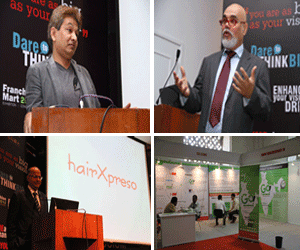For global growth, consumer’s role in the emerging world is indispensable. It makes business sense to get a better understanding of their spending habits, future intentions and the factors influencing them.
Consumers welcomed 2013 on a high note with their confidence building up in anticipation of an improvement in their finances. Countries like Brazil, China and Indonesia leads the confidence curve due to their high income growth expectation while steep decline can be seen in Russia, South Africa and Turkey as their income growth expectations appear faint. India, on the other hand, sees optimism amongst its rich but does not share the same sentiment among the poor.
Credit Suisse Research Institute, recently, interviewed 14,000 consumers from eight developing economies who answered more than 125 questions. According to the report, about 37 percent of the total interviewed people expect their finances to improve in the coming six months while 9 percent believe their finance will deteriorate. The report shows that there is a net improvement of 3 percent and at different national levels Brazil, China and Indonesia.
In numerous countries, most of the working population with high income is young and the perfect example of it is China. In such countries, incomes are not just high but are erupting at tremendous pace.
Now, the growth is expected to be strongest where educated young and wealthy consumers will spend their capital. Food products remain on top of their list of spending. While cars and property remains on strong spending prospects, demand of technology, mobile phones is increasing at an alarming rate. Education and healthcare sectors are likely to get a push to their stalled growth.
Consumers gave a broad view about the economic activities of their respective countries.
Despite the economic slowdown, Brazil remains highly optimistic as both low and high income consumers are confident, unlike other emerging economies. Education stays a priority and products like technology, fashion and spirits are on a continuous rise.
Even Chinese consumer is relatively confident and surprisingly, most of the credit for such confidence goes to low income brackets rather than the high.
The expenditure in smart phones is strongest among all the countries surveyed and technology, education are their key sectors for spending. Similarly, Indonesian consumer confidence rides well with their growing economy. The increase in minimum wages of lower earners contributed to high confidence levels.
Low food prices and rising incomes increased the spending in fashion and holidays while spending in mobile phones continues to grow.
A large disparity was observed between the expectations of rich and poor in Russia. Spending over food consumed most of the consumer incomes, hence restricting them to spend elsewhere and due to the disparity, only the rich half of the Russian population remains active in spend categories. Their spending in technology is relatively higher than any other product. On the brighter end, Saudi Arabian consumer showed the highest optimism among the surveyed countries. However, this is lower than last year, when major government initiatives for employment and incomes boosted their confidence. There is a tremendous growth opportunity in computers, smart phones, fashion apparel and perfumes.
Turkey is placed at the bottom of the eight surveyed countries in terms of optimism, although it witnessed an improvement in overall confidence. Confidence levels are higher among high earners with smart phones, computers, cars, holidays and internet access are where they spend the most. There seems no stop to the growth in alcohol even after the recent tax hikes. Whereas in South Africa, consumers are pessimistic as most of them expect a worse financial position. There was no improvement in the consumer confidence even after broad pay rises. But the institutionalized savings and developed banking system of South Africa has been remarkable.
In India, the gap between the confidence levels of rich and poor consumer continues to grow.
Overall optimism in India is high but the confidence level of poor consumers is declining. With government initiatives implemented, education continues to grow and India turned out to be the only surveyed country where a decline is seen in the craze for smart phones. However, immense promotion of property investment is leading to high expectations for the property prices.
Across 10 cities and rural areas in India, 2602 respondents were asked more than 100 questions for the consumer survey. The key highlights of the Indian Consumer Survey 2013 are:
Decline in consumer optimism
Consumer optimism in India declined greatly last year and there seems no stopping to that fall even this year, due to the high inflation and slower growth. More people expect their finances to worsen and anticipate a lower salary increase than last year, which discourages the possibility of big spending from consumers. With rising economic uncertainty, the savings rate of Indian consumers is increasing at an enormous rate and only 5 percent of the consumers surveyed expect the inflation to fall. Even the confidence in the government is diminishing as only 35 percent believes it is effective in solving problems, unlike the 50 percent last year.
Just 5 percent expect inflation to fall in the coming year while 60 percent thinks it will increase further. High percentage of rural and low income population seems to be more concerned about inflation and apparently, inflation has hit them the hardest.
High inflation expectations incurred in people’s mind is a worrying trend.
Only 30 percent respondents saw pay rise and income of 20 percent came down in 2012. Hence, the confidence fell in making major purchases to 59 percent. And 11 percent expect their finances to get worse. About two years ago, confidence level among Indians was very high regarding their personal finances but since then there has been a constant decline. Only 4 percent are trading in the stock markets as the current economic uncertainty is making the consumer too reluctant to invest. Indians are saving more and cutting down the expenditures on housing and education with percentage of income saved increasing to 32 percent in 2012.
Down-trading in discretionary items
Even though people kept buying items like apparels, shoes, watches and perfumes, there was a fall in mean purchase values with consumers preferring to cut down on discretionary spending to save more.
The preference for branded products was on a constant increase until 2012.
Indian consumer became brand conscious which resulted in high demand of branded products in 2011.
But there seems to be a trend reversal in 2012 as demand of unbranded items has drastically increased again. More people wanted to buy a cheaper car while there has been a clear trend towards up-gradation in cars. Few people bought smart phones as compared to 2011 but the mobile phones were purchased relatively more.
Rural on high while urban declines
While the mean household income of rural India increased by 6 percent, it decreased by 3 percent for urban. The spending patterns show a major difference across rural and urban India. Rural India witnessed a strong growth in past two years as number of people owning cars in rural areas had doubled from 2011 whereas urban regions saw decrease in car penetration. People from rural regions continue to buy branded products with apparels, watches and sport shoes all facing lesser unbranded purchases while an increase in demand for unbranded goods is seen among urban consumer of India.
And this is followed in all categories as mean purchase value in urban areas saw a big decline while rural consumer witnessed a relatively less fall. Now, with most big retail brands taking the route to Tier 2 and Tier 3 cities to open their stores, the best products in the market will not be restricted to just urban India anymore. Even the people
in rural India are ambitious to try more fashionable and expensive goods.
Computer penetration was stable in urban areas while it increased to 0.3 percent in rural. With the ratio of rural to urban population in India at 70:30, strong rural performance would continue to support the growth of Indian consumer companies.
Low penetration bodes well for growth
Out of the total eight countries surveyed, Indians are among the lowest consumers of items like beer, spirits, meat, cigarettes and LCD televisions and have the lowest access to internet. Low penetration in India across various categories is another optimistic factor for the long term growth. While the spending on education is declining at 10 percent of the total household income which is still very high compared to other countries. India has the highest percentage of people who prefer private schools for their children but in 2012, a drop was observed. India is strengthening its cornerstones to capitalize on the demographic dividend which it is expected to relish in the coming decades as the nutrient content in the dairy patterns is going up as consumption of meat and dairy products is also increasing greatly.
Key Takeaways:
Population analysis
In an interview of 2,620 people from various cities of India, 70 percent respondents were from the urban areas and 60 percent were males. Most of the respondents were below 45 years of age and average monthly income turned out to be Rs. 21,000 as majority of them earning between Rs. 10,000 and Rs. 30,000.
Consumer spending
Indians are now saving more while food remains the biggest segment of the monthly household spending. There was a decline seen in housing from 15 percent to 11 percent and more to the misery was the 10 percent fall in income allocated to education by rural and urban people.
Automobile
Car penetration in urban areas went down, which seems to indicate the rising fuel costs due to which people in cities are using public transport and similar trend is seen in two wheelers. With less than 7 percent people owning cars, India is the most under penetrated car market in the world whereas 70 percent of rural people own a two wheeler which is higher than the national average of 30 percent. Rural area beats urban a big time in the two wheeler segment. People owning multiple cars saw an increase from 6 percent to 11 percent suggesting a rising need of individual cars for daily travel.
Electronic goods
Demand of electronic goods remains low and hence in India, the up gradation of these things reach in a long time, especially when compared to other countries.
The purchases of lower priced items remain high while other electronics good are purchased less. Furthermore, people expecting to switch to DTH from cable TV are lesser than in 2011 and the DTH penetration remains low.
There are no advanced privileges in shifting to DTH and higher prices impede the consumer to make the switch.
Education
Illiteracy in India is very high but optimism is observed among illiterate people as they are participating more in adult education programmes and there is an increase observed in children who are active beyond the normal school educational activities. Education is increasing year by year but most people prefer the private educational institutions for their children as there are concerns over the academic standards of the government schools and colleges. The rural population and the lower income category saw a big leap in respondents’ desire to get better education for their children.































 +91 9909960054
+91 9909960054